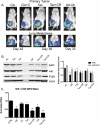Caloric restriction counteracts chemotherapy-induced inflammation and increases response to therapy in a triple negative breast cancer model
- PMID: 29912618
- PMCID: PMC6133339
- DOI: 10.1080/15384101.2018.1471314
Caloric restriction counteracts chemotherapy-induced inflammation and increases response to therapy in a triple negative breast cancer model
Abstract
Triple negative breast cancer (TNBC) is a heterogeneous disease that has no available targeted therapies. Previously, we have shown that caloric restriction (CR) can augment the effects of radiation therapy in a TNBC mouse model. To build upon this, we now present data regarding the combination of chemotherapy and CR in the same 4T1 model. Chemotherapy can induce inflammation that breeds resistance to therapy. We propose CR as a mechanism to decrease chemotherapy-induced inflammation and increase efficacy of therapy. 12-week old Balb/c mice were orthotopically injected with a syngeneic triple negative breast cancer cell line (4T1) and were treated in one of six cohorts: ad lib fed (AL), 30% reduction in calorie intake (CR), cisplatin or docetaxol alone or a combination CR+cisplatin/docetaxol. Mice in the cohorts receiving chemotherapy+CR had longer overall survival (12 ± 2 days) as compared to the AL group. These mice also demonstrated less lung metastases at the final time point of in vivo imaging. In addition, downregulation of the IGF-1R and IRS signaling pathways were noted most significantly in those mice receiving combination therapy. Lastly, serum from these mice demonstrated an increase in inflammatory cytokines TNF-α and IL-1β in response to chemotherapy alone. This increase was dampened by the addition of CR. Taken together, these data suggest that while chemotherapy is effective in TNBC, it can cause inflammation, which can be a driver of resistance to therapy. This chemotherapy-induced inflammation can be reversed with the use of CR as a nontoxic adjunct to treatment.
Keywords: Diet; adipokines; breast cancer; chemotherapy; inflammation.
Figures



Similar articles
-
Caloric restriction coupled with radiation decreases metastatic burden in triple negative breast cancer.Cell Cycle. 2016 Sep;15(17):2265-74. doi: 10.1080/15384101.2016.1160982. Epub 2016 Mar 30. Cell Cycle. 2016. PMID: 27027731 Free PMC article.
-
Effects of calorie restriction and IGF-1 receptor blockade on the progression of 22Rv1 prostate cancer xenografts.Int J Mol Sci. 2013 Jul 3;14(7):13782-95. doi: 10.3390/ijms140713782. Int J Mol Sci. 2013. PMID: 23823800 Free PMC article.
-
Insulin-like growth factor receptor signaling in breast tumor epithelium protects cells from endoplasmic reticulum stress and regulates the tumor microenvironment.Breast Cancer Res. 2018 Nov 20;20(1):138. doi: 10.1186/s13058-018-1063-2. Breast Cancer Res. 2018. PMID: 30458886 Free PMC article.
-
Targeted Therapies for Triple-Negative Breast Cancer.Curr Treat Options Oncol. 2019 Nov 21;20(11):82. doi: 10.1007/s11864-019-0682-x. Curr Treat Options Oncol. 2019. PMID: 31754897 Review.
-
Current treatment landscape for patients with locally recurrent inoperable or metastatic triple-negative breast cancer: a systematic literature review.Breast Cancer Res. 2019 Dec 16;21(1):143. doi: 10.1186/s13058-019-1210-4. Breast Cancer Res. 2019. PMID: 31842957 Free PMC article.
Cited by
-
Consideration of Ketogenic Metabolic Therapy as a Complementary or Alternative Approach for Managing Breast Cancer.Front Nutr. 2020 Mar 11;7:21. doi: 10.3389/fnut.2020.00021. eCollection 2020. Front Nutr. 2020. PMID: 32219096 Free PMC article. Review.
-
The Role of the Microbiome and of Radiotherapy-Derived Metabolites in Breast Cancer.Cancers (Basel). 2024 Oct 30;16(21):3671. doi: 10.3390/cancers16213671. Cancers (Basel). 2024. PMID: 39518108 Free PMC article. Review.
-
Calorie restriction and breast cancer treatment: a mini-review.J Mol Med (Berl). 2022 Aug;100(8):1095-1109. doi: 10.1007/s00109-022-02226-y. Epub 2022 Jun 27. J Mol Med (Berl). 2022. PMID: 35760911 Review.
-
Metabolic Constrains Rule Metastasis Progression.Cells. 2020 Sep 11;9(9):2081. doi: 10.3390/cells9092081. Cells. 2020. PMID: 32932943 Free PMC article. Review.
-
Dietary regulation in health and disease.Signal Transduct Target Ther. 2022 Jul 23;7(1):252. doi: 10.1038/s41392-022-01104-w. Signal Transduct Target Ther. 2022. PMID: 35871218 Free PMC article. Review.
References
-
- Liedtke C, Mazouni C, Hess KR, et al. Response to neoadjuvant therapy and long-term survival in patients with triple-negative breast cancer. J Clin Oncol. 2008. March 10;26(8):1275–1281. PubMed PMID: 18250347. - PubMed
-
- Cortazar P, Zhang L, Untch M, et al. Pathological complete response and long-term clinical benefit in breast cancer: the CTNeoBC pooled analysis. Lancet. 2014. July 12;384(9938):164–172. PubMed PMID: 24529560. - PubMed
Publication types
MeSH terms
Substances
LinkOut - more resources
Full Text Sources
Other Literature Sources
